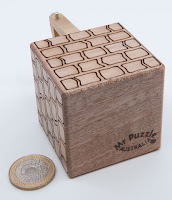Short version: Classic puzzle from the master of sequential
discovery, Brian Young.
Slightly longer version: When I saw the warning email from
Sue about the upcoming release I made sure I’d left a note for myself to check
the website on the right day – sure, there would be 150 copies available on the
first day (with another 350 along behind that at some point) but there are lots
of puzzlers out there that know just how good Brian’s puzzles are. Add to that those
two magical words: “sequential discovery” and you can be sure that there’s
going to be a huge amount of interest…
In the end, the ordering process was pretty straight-forward
and I even managed to add a couple of other things to the order that I’d been
meaning to pick up for a while, as well as some of their discounted own-brand
disentanglements (mainly because I’m rubbish at those and desperately need the
practice!).[That first batch only lasted 12 hours...!]
EMS then teased me for over a week with my care package
apparently sitting on the tarmac in Brisbane being “Processed by air carrier” daily,
but seemingly making no headway whatsoever. Once or twice Nigel and I swapped
messages as both of our packages seemed to be stuck in the same limbo… and then
all of a sardine, that changed and AusPost let me know my parcel had landed in the
UK… and a day or two later it duly arrived in Barnt Green… this past Friday…
Yesterday I took it out for a bit of a play and found myself
getting somewhat hooked on it – it makes for a nice little hand-full. There’s
some lovely silky wood for the base and some very neat brass and steel work on
the upper half. It thoroughly looks the part – right down the etched brickwork
on the sides of the well. There’s a little bit of rope hanging down into the brass-lined(!)
well, but no apparent pail. As you’d expect, there’s the usual Mr Puzzle
branded logo on the base… and ostensibly, that’s all!
A closer examination yields a hole in the brass well-lining,
and the cross-bar at the head of the well seems to turn forever… those two
little screws at the head of the well may well have knurled edges, but there’s
no way that you’re going to undo those without a more appropriate tool than
your hands.
And that dear reader, is it… nothing seems to move, nothing
seems untoward – there is nowhere to go… so you might as well start puzzling a
little more seriously now. Or decide that you’ve bought a well-made ornament
for your puzzle cave.
Over the course of Saturday I found myself puzzling in
spurts – using my normal attack of puzzle until I get frustrated with a lack of
progress – put the puzzle aside and then spending some time Think(c)ing – and return
to said puzzle with a new line of attack…
That approach served me quite well over the course of Saturday
and by the early evening I had a growing pile of pieces, some of which had been
pretty handy as tools and I was more or less running out of places to go on
this little puzzle – which concerned me a little as I knew I wasn’t finished
yet: Brian is clear that when you’re finished, you’ll know it and you'll have a pewter
object that links the well and Australia (which is all rather intriguing).
I knew I wasn’t finished as I hadn’t found anything made of
pewter yet…
So I left it on the desk in bits and returned to it again
this morning… and managed to spot something I’d overlooked the night before and
a couple of minutes later I had my little pewter prize in my sweaty little paws… with a huge
grin on my face.
Abraham’s Well shows that Brian’s not only a great designer
of puzzlers’ puzzles, but he also has a wicked sense of humour… early on I thought
I really wanted something, and Brian delivered – exactly the wrong thing! I’m
pretty certain that he knew exactly what he was doing – I can see him sitting there saying to himself “Let’s get their hopes up and then crush them – it’ll be fun!”.
Brian’s description of the puzzle talks about having twenty
odd bits and pieces by the time you’ve taken it all apart, with quite a few of
them being quite useful little tools – only, working out which of them are tools
and which aren’t is at least half the fun. [I imagined some wonderfully complicated
tools during the course of my solve!]
Having got to the end of the solve, and then reassembling it
for the requisite photographs, I
knew which puzzle I was going to be writing
about this week – in fact I’m probably not going to shut up about how good this
one is for a while!
If you missed out on the first batch, there’s another 350 of
them along in due course… Brian’s hoping to have them in his shop for a while… I’m
not sure how successful he’s going to be at that – it is an excellent puzzle –
you (and all of your puzzling friends) will want one.











